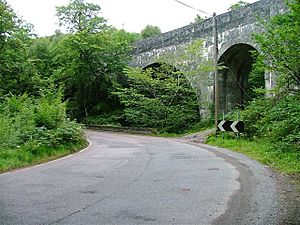Larichmore Viaduct facts for kids
Quick facts for kids Larichmore Viaduct |
|
|---|---|
 |
|
| Coordinates | 56°54′44″N 5°49′18″W / 56.9123°N 5.8216°W |
| Carries | West Highland Line |
| Crosses | Brunery Burn |
| Characteristics | |
| Material | Concrete |
| Number of spans | 3 |
| History | |
| Construction begin | 1897 |
| Opened | 1901 |
The Larichmore Viaduct is a special railway bridge in Scotland. It helps the West Highland Line railway cross over a small river called the Brunery Burn.
Building the Larichmore Viaduct
This important bridge was started in 1897 and opened in 1901. It was built to carry trains on the famous West Highland Line.
The West Highland Railway was built to Fort William by Lucas & Aird, but there were delays with the West Highland Railway Mallaig Extension (Guarantee) bill for the Mallaig Extension Railway in the House of Commons as the Tory and Liberal parties fought over the issue of subsidies for public transport. This Act did pass in 1896, by which time Lucas & Aird (and their workers) had moved south. New contractors were needed and Robert McAlpine & Sons were taken on with Simpson & Wilson as engineers. Robert McAlpine & Sons was headed by Robert McAlpine, nicknamed "Concrete Bob" for his innovative use of mass concrete. Concrete was used due to the difficulty of working the hard schist in the area. McAlpine's son Robert, then aged 28, took charge of construction, with his younger son Malcolm appointed as assistant.
Construction of the extension from Fort William to Mallaig began in January 1897, and the line opened on 1 April 1901.
In 1980, the Larichmore Viaduct was officially recognized as a "Category B listed building." This means it's a historic structure that needs to be protected because of its special importance.
How the Viaduct Looks
The Larichmore Viaduct is made of strong concrete. It has three arches, which are curved supports that help the bridge stand firm.
The middle arch is the longest, stretching 50 feet (15 m) across. The bridge also has a curve, like a gentle bend, with a radius of 200 metres (660 ft). It crosses the Brunery Burn very close to the A830 road.

